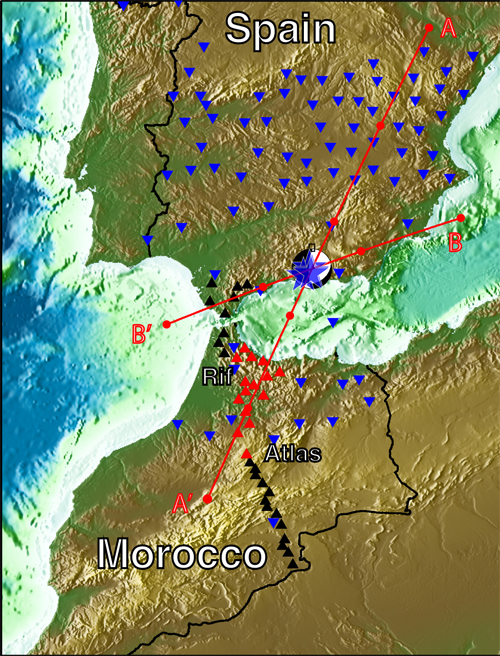
mediterranean from space
As Africa and Eurasia slowly collide, Earth’s rumblings paint a seismographic picture of what once was a piece of our planet’s surface now lying upside down deep beneath the Mediterranean.
Spain’s unusually prone to rare, deep earthquakes, and a new study suggests this capsized tectonic slab might have something to do with it.
“Since 1954, there have been five closely located large deep‐focus earthquakes with depths greater than 600 kilometers beneath [the Spanish city of] Granada,” explain geologists Daoyuan Sun from the University of Science and Technology of China and Meghan Miller from Australian National University.
Earthquakes at such depths are usually followed by significant aftershocks. But when Sun and Miller examined seismic data from Spain’s 2010 earthquake, there were no aftershocks to be seen.

Triangles mark seismic stations across Spain and Morocco, red indicate those used to study the strange slab. (Sun and Miller, The Seismic Record , 2024)
When tectonic plates push into each other, they’re often displaced so one slides beneath the other in a process called subduction. Sometimes these collisions destroy the sinking part of the plate, raising the crust to create mountains and interlocking the two plates’ fates as one.
Other times the wrestling crusts will remain separate but stacked, with one slab gradually sinking further towards Earth’s mantle. This is what’s happening at the border between the African and Eurasian plates, where the Mediterranean floor is gradually sinking beneath Europe.
A subducted slab forms hydrous magnesium silicates in its uppermost layers when they’re exposed to ocean water. As the slab sinks, these silicates dehydrate and become more brittle, becoming more prone to earthquakes and slowing seismic waves in a way that can be detected by seismologists.
The seismic waves during the 2010 Granada earthquake lasted unusually long and had a late extra phase of activity. This could be explained by the seismic waves moving slower at the bottom of the Alboran slab instead of the top.
“A significant amount of water has been carried down to the mantle transition zone, indicating a relatively cold slab,” explains Sun.
“Considering a relatively young seafloor age in the western Mediterranean, for the slab to remain cool, the subduction speed must be quite fast, such as a moderate speed of about 70 millimeters per year.”
It seems the rapid speed of slab sinking helped this part of Earth’s crust to flip over, taking a pocket of water with it. This slab rollback process occurs when gravity helps pull the slab into a vertical downward rotation, like a nosedive.
The new study goes a step further by concluding it has completely overturned, landing silicate-side-down in a way that could explain the strange complexity of the region’s tectonic structures and occasional earthquakes greater than 600 kilometers deep.
“[This] confirms that the slab beneath the Betics of southern Spain is a subducted oceanic lithosphere,” the team writes, explaining this process formed the Beltic-Rif (or Gibraltar) arc that shapes the western Mediterranean.
This research was published in The Seismic Record.
News Related-
High court unanimously ruled indefinite detention was unlawful while backing preventive regime
-
Cheika set for contract extension as another Wallabies head coaching candidate slips by
-
Analysis-West's de-risking starts to bite China's prospects
-
'Beyond a joke' Labor won't ensure PTSD protections: MP
-
Formula One season driver ratings: Lando Norris shines as Max Verstappen nears perfection
-
Catalina golfer Tony Riches scores Guinness World Record four holes in one on same hole
-
Florida coach Billy Napier fires assistants Sean Spencer, Corey Raymond with expected staff shakeup ahead
-
Rohingyan refugee NZYQ accidentally named in documents published by high court
-
Colorado loses commitments of 2 more high school recruits
-
Queensland Health issues urgent patient safety alert over national bacteria outbreak
-
Townsville Community Pantry 'distressed' by fruit, vegetable waste at Aldi supermarket
-
What Is The Beaver Moon And What Does It Mean For You?
-
Labor senator Pat Dodson to resign from politics due to health issues
-
Hamas releases 11 more hostages, as Israel agrees to extend ceasefire
